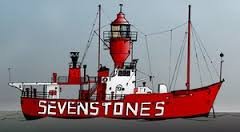


Midway between Land's End and The Isles of Scilly
Tel: (01736) 786900
Email: enquiries@trinityhouse.co.uk
Web: www.trinityhouse.co.uk/lighthouses-and-lightvessels/sevenstones-lightvessel
Map
Seven Stones Lightship is a lightship moored off the Seven Stones Reef which is nearly fifteen miles to the west-north-west of Land's End, and seven miles east-north-east of the Isles of Scilly. The reef has been a navigational hazard to shipping for centuries with 71 named wrecks and an estimated 200 shipwrecks overall, the most infamous being the oil tanker the Torrey Canyon on 18th March 1967.
Deriving from the legend of the Lost Land of Lyonesse, the 'City of Lions' was said in some later traditions to be the capital of the legendary kingdom, situated on what is today the Seven Stones reef.
The rocks are only exposed at half tide and it was not feasible to build a lighthouse so a lightship was provided by Trinity House. The first was moored near the reef on 20th August 1841 and exhibited its first light on 1st September 1841. She is permanently anchored in 40 fathoms and is 2.5 miles north-east of the reef. Originally there was a crew of ten with five on station at a time. Since 1987, the Seven Stones Lightship has been automated and unmanned.
The first lightship was built by William Pitcher of Thames Ironworks and Shipbuilding Company, Blackwall, the cost of the hull came to £3,128 8s and the fully equipped vessel £4,416 8s 7d. Built of wood, with a tonnage of 162, her length was 80 feet, breadth 21 feet and her two masts for the lights were 69 feet and 60 feet tall. Red balls were fixed on each mast to distinguish her from other lightships. The two lights were displayed at 38 feet and 20 feet, were of the catoptric system and could be seen from ten miles away. She also carried a gong fog signal.
Relief occurred monthly with the master or mate and twelve men always on board, with the other officer and three men on shore in rotation. Houses were provided on Tresco for the crew and provisions were procured by crew members rowing and sailing to New Grimsby in the vessel's longboat. Two of the crew drowned on 15th October 1851 when one of the lightship's longboats capsized in a squall, while on a journey from Scilly with stores.
The second lightship was built by H & C Grayson, of Liverpool in 1914. She was 116 feet long, had a breadth of 26 feet and was 318 tons. In 1954 she undertook a refit with the provision of hot water, electric lighting, refrigerator, one and two-berth cabins and a roomy mess deck. Daily work on the ship such as watch-keeping and maintenance of the 600,000 candle power lantern could be carried out without going outside. Before, the refit crew had to climb up the mast every morning to trim the lamps, hauling their supply of oil with them; a dangerous task in rough weather. She took up her position during the Second World War and was replaced with a lighted buoy after being frequently bombed and machine-gunned by German pilots. She broke adrift in March 1948 and her engine failed in November 1950. She was replaced in 1958.
The third lightship was built by Philip and Son of Dartmouth and launched on 30th May 1958 and the Seven Stones was her first station. She was 133 feet long and 26 feet wide, a gross tonnage of 390 and cost £118,854. She had the same 600,000 candle power as the previous ship and shone a group of three white flashes every thirty seconds, visible in good conditions to eleven miles. She was on station when the Torrey Canyon became, at that time, the largest shipwreck in world history. The lightship was towed to Penzance for a few days while the wreck was bombed by Fleet Air Arm aircraft; in an attempt to release the remaining oil on board and set fire to it.
The fourth lightship was built by Richards Shipbuilders of Lowestoft in 1967 with a displacement of 390 tons. Her length was 114 feet and breadth 26.5 feet and she was on station from 1998 to 2001. She is currently the St. Gowan lightship. She was replaced again in 2004. The lightship also serves as an automated weather station for the UK Met Office and is owned and maintained by Trinity House. On board equipment measures air pressure, wind strength and direction, temperature and humidity. The lightship also carries a Ship Borne Wave Recorder and measures significant wave heights on an hourly basis. Since 1987, the ship has been automated and unmanned with the accommodation and storage areas filled with foam to help with buoyancy in the event of a collision.
The National Lighthouse Centre Cornish Lighthouses Cornwall's Shipwrecks Land's End
The Isles of Scilly Shipwrecks Around The Isles of Scilly St. Martin's Daymark